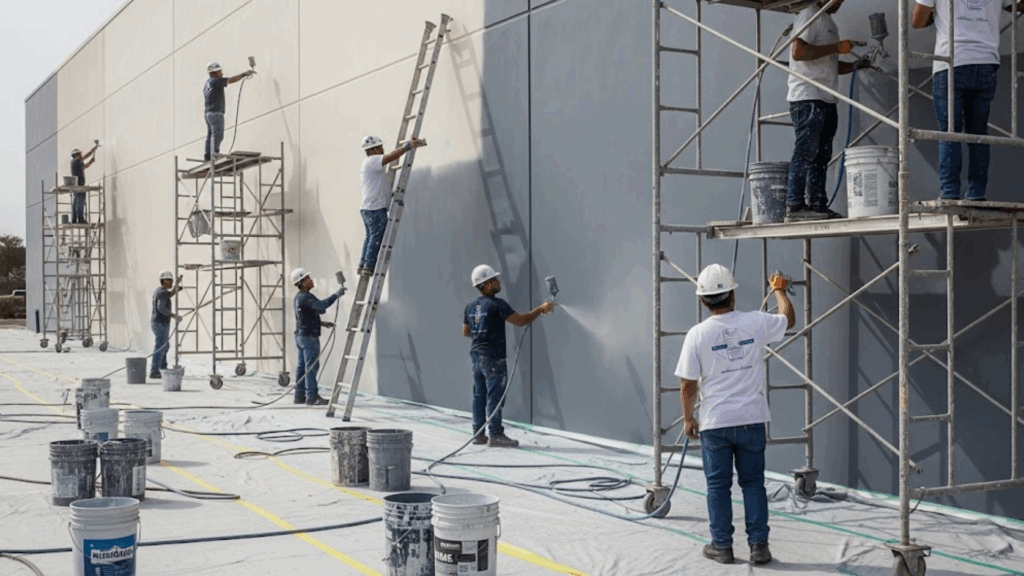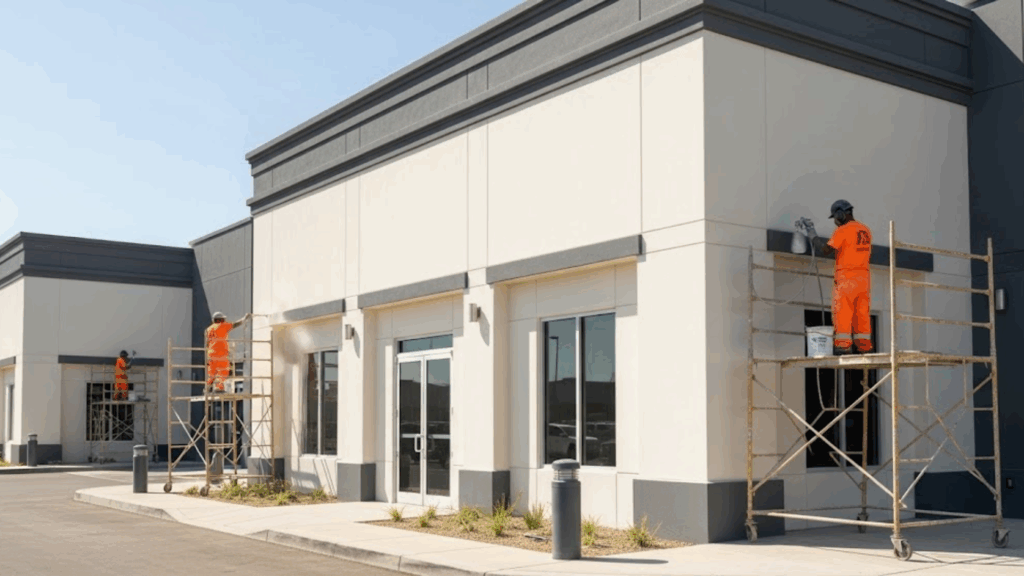When I walk past a commercial building, the exterior is usually the first thing I notice – and I’m not alone.
Whether it’s a modern office park, a busy retail store, or a high-traffic warehouse, how it looks from the outside sets the tone.
Faded paint, stains, or chipped walls can discourage potential clients and even affect foot traffic. That’s why more companies across the U.S. are opting for professional exterior painting.
It’s not just about a fresh coat; it’s about making the right impression, safeguarding your property, and showing care in your company’s presentation.
In this blog, I’ll explain what to expect from commercial painting services, how to choose the right professionals, and why this investment has lasting value.
Why Commercial Exterior Painting Matters
Painting your commercial property does more than maintain appearance; it enhances curb appeal, protects against damage, reinforces brand consistency, and helps meet local building regulations and standards.
- First Impression Counts: A clean, well-maintained exterior paint job conveys professionalism and reliability. Peeling paint signals neglect, while fresh paint shows attention to detail and creates strong first impressions.
- Protection from the Elements: Exterior paint acts as a shield against sun, rain, wind, and temperature changes. Neglecting maintenance can lead to issues like mold, peeling, or cracked siding.
- Brand Identity and Compliance: Paint color reflects your brand identity and ensures consistency with franchise guidelines. Professional painters help maintain alignment with brand standards and local regulations.
A well-painted exterior not only protects your building but also enhances your brand’s image and longevity.
What to Expect from Commercial Painting Services

Commercial painting services typically include inspection, surface preparation, material selection, application, and cleanup, each step designed to ensure a durable, high-quality finish with minimal disruption.
1. Site Evaluation and Strategy
Painters begin with a thorough inspection to spot damage, paint failure, or moisture issues. They evaluate the building’s surface type and condition, then recommend the most suitable paints, coatings, and prep work.
This ensures the final application adheres well, performs effectively, and provides long-lasting protection against weather and wear.
2. Prep Work is Key
Proper prep work involves pressure washing, scraping off loose paint, sanding rough areas, caulking gaps, and applying primer.
These steps create a clean, stable surface that helps paint adhere better and last longer. Skipping preparation can lead to early failure, peeling, or uneven results, making it a crucial part of the process.
3. Professional Tools and Durable Materials
Commercial painters use specialized tools like sprayers, scaffolding, and high-quality, weather-resistant paints. These materials are built for durability and efficiency, especially on larger buildings.
The right equipment ensures thorough coverage, long-term protection, and a smooth finish, making the job faster, safer, and more effective for demanding commercial exterior projects.
4. Flexible Work Schedules
To minimize disruption, many commercial painters schedule work during evenings, weekends, or in phases. This approach allows your business to stay open and operate as usual while the painting progresses.
It’s a practical solution that balances productivity with improvement, ensuring minimal impact on customers, staff, and daily business activities.
Choosing the Right Contractor for Exterior Commercial Painting
Selecting the right painting contractor leads to higher-quality results, fewer delays, and smoother communication, helping your project stay on time, on budget, and professionally executed.
1. Prioritize Commercial Experience
Choose contractors with a strong track record in commercial spaces like offices, retail buildings, or hospitality sites.
Ask for examples of similar completed projects to confirm they understand the scope and challenges of your property type.
Past experience helps ensure they can deliver consistent, efficient, and high-quality work.
2. Licensing and Insurance
| Requirement | What to Check for |
| Business License | Valid and current license to operate in your area. |
| General Liability Insurance | Coverage for property damage or accidents. |
| Worker’s Compensation | Insurance protects workers in case of injury. |
| OSHA-Trained Crew | Team trained in job site safety standards. |
| Written Agreement | Detailed contract outlining terms and responsibilities. |
This protects both parties during the project.
3. Ask for a Portfolio and References
A reliable contractor should gladly offer project photos and references from past clients.
Reviewing their previous work and speaking to former customers gives you insight into their quality, professionalism, and ability to handle similar jobs.
This simple step helps you make a more informed and confident hiring decision.
4. Clear Bids and Contracts
| Item | Details to Expect |
| Project Space | Areas to be painted and overall work to be completed. |
| Prep Work | Surface cleaning, repairs, sanding, priming, etc. |
| Paint Brands & Finishes | Specific products, colors, and finish types used. |
| Timeline | Start and end dates, including work schedule. |
| Cleanup Plan | How will the site be cleaned after completion? |
| Final Cost & Payment | Total price, payment terms, and due dates |
Tip: Avoid vague pricing or informal agreements.
Surfaces Commonly Painted in Exterior Commercial Settings
Various surface types need unique paints and preparation methods to ensure proper adhesion, durability, and long-term protection in commercial settings.
- Concrete/Masonry: Needs flexible, crack-resistant coatings like elastomeric paint
- Metal: Requires rust-resistant primers and UV-stable finishes
- Wood Fascia and Trim: Must be sealed, sanded, and primed to avoid rot or peeling
- EIFS and Synthetic Stucco: Need breathable paints to prevent moisture buildup
Paint Types and Coatings to Know for Exterior Commercial Paint
Each coating serves a different function depending on the material and environment.
| Paint Type | Description | Ideal For | Regional Needs |
|---|---|---|---|
| Acrylic Latex | Versatile, fast-drying | Wood, masonry, and vinyl | Southeast: Mildew-resistant paints and quick-dry primers |
| Elastomeric | Thick, water-resistant | Stucco and concrete | Northeast: Flexible coatings for freeze-thaw cycles |
| Urethane/Epoxy | High durability | Metal, doors, and trim | Southwest: UV-resistant paints that don’t fade |
| Low-VOC/No-VOC | Safer for sensitive environments | Schools, clinics, and indoor spaces | Pacific Northwest: Breathable, mildew-fighting formulas |
| All-Weather Coatings | Durable in extreme weather | General use in various climates | Midwest: All-weather coatings for seasonal swings |
Exterior Commercial Painting: Cost and Timeline Breakdown
Quick Reference Table
| Project Size | Approx. Square Footage | Estimated Cost | Estimated Timeline |
|---|---|---|---|
| Small Storefront | 3,000 sq ft | $5,000–$10,000 | 5–7 days |
| Medium Office Building | 10,000 sq ft | $15,000–$35,000 | 7–10 days |
| Large Warehouse | 20,000+ sq ft | $40,000 and up | 10–14+ days (or phased work) |
Costs depend on:
- Surface condition
- Building height
- Paint type
- Accessibility
- Local labor rates
Maintenance for Exterior Painting
Once the job is complete, the painting team will inspect the work with you, address any final details, and ensure quality results that stand the test of time.
Walkthrough and Touch-Ups
After the painting is complete, the crew will walk through the site with you to check the work, fix any missed areas, and ensure everything meets expectations.
They’ll also handle cleanup and share care guidelines to help maintain the finish and extend the life of your building’s new exterior.
Maintenance Plans
Some painting companies provide scheduled inspections and minor touch-ups. These services help catch issues early and prevent larger problems.
Regular maintenance keeps the paint looking fresh, extends its durability, and delays the need for a full repaint, saving money and preserving your building’s appearance over the long term.
Warranty Coverage
Choose a paint warranty that includes both materials and labor. Reliable warranties typically range from 2 to 10 years, based on the type of paint and application system.
This coverage protects your investment and offers peace of mind in case of premature wear, peeling, or product-related issues over time.
Conclusion
In today’s competitive landscape, how your business looks from the outside is just as important as what happens inside.
A clean, well-painted commercial exterior creates a positive first impression, sends a message of professionalism, and helps you stand out in a crowded market.
Beyond appearances, it also plays a practical role in protecting your structure from weather, wear, and costly repairs over time.
With experienced painters, high-quality materials, and thoughtful planning, an exterior paint job becomes more than upkeep; it becomes a smart investment in your property’s value, image, and durability.
If your building shows visible signs of aging like faded paint, peeling trim, or water stains, it’s time to act. Don’t let a worn exterior send the wrong message.
Contact a trusted commercial painting company and give your property the attention it deserves, layer by layer.

